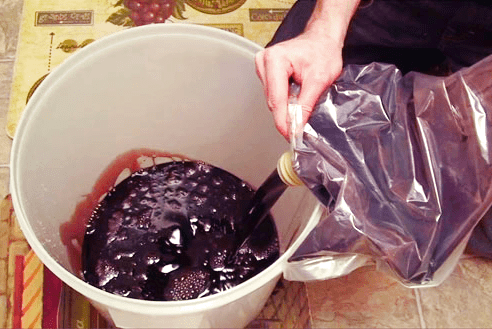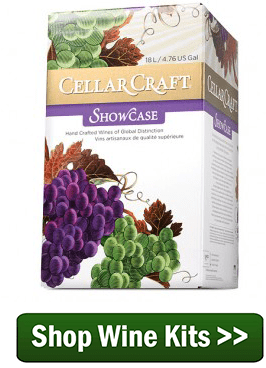 Hi everyone!
Hi everyone!
If you recall from my last entry, I had just started making another wine ingredient kit – a Ken Ridge Classic Nebbiolo. The primary fermentation was just bubbling away and everything seemed to be going smoothly.
To prepare for secondary fermentation, I was a little curious how I was going to keep the elderberries that came with the kit and were now floating in the wine, from transferring through the tubing into my clean carboy. I suppose if I had used my racking cane with the little red cap on the bottom this wouldn’t have been an issue at all, but since my primary fermenter has a spigot on it, I decided to just hook up the siphoning hose directly to the spigot and transfer away with the flip of a switch.
Since I didn’t have any sort of filter in front of the spigot nor did I have the elderberries in any sort of cheesecloth or bag, I improvised by placing a piece of paper towel in front of the hole of the spigot to keep the large pieces of elderberries from transferring into my clean carboy for secondary fermentation. I don’t know if this was the smartest idea, but the towels were clean and as far as I could tell, sanitary. I think next time this happens when making a wine ingredient kit, I’ll just go ahead and use the racking cane, or maybe fish the elderberries out first prior to transferring the wine over.
 Other than this little improvisation, secondary fermentation went along just swimmingly. 12 days later, I performed the degassing stage which like secondary fermentation, went along just fine.
Other than this little improvisation, secondary fermentation went along just swimmingly. 12 days later, I performed the degassing stage which like secondary fermentation, went along just fine.
The only issue that came up here is that only now did I realize that I forgot to add the oak granulars way back in primary fermentation! I don’t know how I managed to do that, other than the fact that when I opened the drawer that the granulars were in, I noticed they were all the way in the back of the drawer so I had somehow missed them the first time around. Smooth.
While I was temporarily upset that I forgot to add the oak while making this wine ingredient kit, I decided that it didn’t really matter too much and that I would just be making a very fruit forward Nebbiolo instead of a more standard style. These little mistakes can come back to bite you sometimes, while other times, it doesn’t really matter too much if the wine is most likely only going to be consumed by you and your partner!
———————————–
 My name is Leigh Erwin, and I am a brand-spankin’ new home winemaker! E. C. Kraus has asked me to share with you my journey from a first-time dabbler to an accomplished home winemaker. From time to time I’ll be checking in with this blog and reporting my experience with you: the good, bad – and the ugly.
My name is Leigh Erwin, and I am a brand-spankin’ new home winemaker! E. C. Kraus has asked me to share with you my journey from a first-time dabbler to an accomplished home winemaker. From time to time I’ll be checking in with this blog and reporting my experience with you: the good, bad – and the ugly.

Regarding the elderberries from your Nebbiolo, using a piece of cheesecloth cut in a square and putting the berries in the center, tie the corners to each other or secure with a plastic tie wrap to make a small packet to go into the fermenter and can easily be removed and disposed of after racking. The same principle as the mesh fermentation bags that are such a labor saver. This will work for the oak chips or any ingredient that you do not want to fish out of your must after fermentation. Just sterilize the cheesecloth as you would any of your equipment.
P.S. I don’t think anyone would notice the missing oak chips from the Nebbiolo if you did not tell them and they would surely enjoy it very much nonetheless.
Your Bulk Aging now You could always just buy Oak Cubes
Lightly toasted American Oak Will impart Vanilla
Highly Toasted French Caramel (for big reds)
I forgot some since I took a break a year of making wine on a extended vacation,
but I’m sure Ec krase could help —
I think your looking for a lightly toasted Oak, though from how you explain your wine
They also have Hungarium oak
Oh yeah I was like this when I first started too anal Things need to be sanitary and all but I wouldn’t worry too much , and a little berries get into secondary I wouldn’t worry
as well as a little lees (heavy lees) in secondary while racking the first time.
Or even later on you could age on the (fine) lees Sur lees (A French thing use it on Whites)
OF course there are a lot of different ways to do things
Like raking earlier , and pouring the wine into a funnel from Vat to Demi
getting more oxygen into it, EARLY not to Oxidize it..
instead of a paper towel you could of used a old Pair of Panty hose soaked in potassium Metabisulfite (K- meta) I do not like the Nylon anymore to ferment with in a vat or paint straining bags etc, but have used cheese cloth like mentioned, with fruit tied inside…
would be nice To have a stainless steel mesh bag.
I see in the picture that you took the kit out of the box. I have seen comments that stated they lost some juice because the bag is so hard to handle. Read the directions, do not take the bag out of the box until you are ready to add a little warm water to get all of the juice out.
I made thirty-six galllons of Ziinfindil in 2011.
The wine tastes delicious. However, I evidently didn’t rack it properly and the bottled wine has sediment, not a lot but enough to spoil the looks.
Can I take care of this problem by emptying all the bottles in my 40 gallon container and then after a time re-rack the batch?
Thanks,
Frank
.
Frank, while it is not harmful to consume the wine, if you are concerned with the appearance you can certainly put it back in bulk and allow it to settle out. When it is time to re-bottle the wine you want to add another dose of campden tablets. This will protect the wine as well as drive out any oxygen the process may introduce.